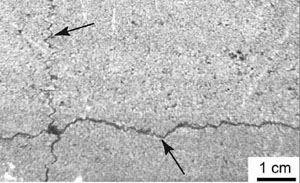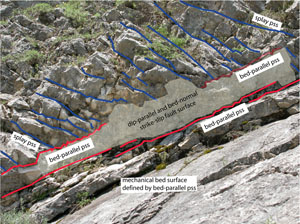| |||||||
|
|
|||||||
|
|
|||||||
| Multiple Pressure Solution Seam Sets | |||||||
|
Similar to the multiple joint sets categories, we consider multiple pressure solution seam sets as (1) orthogonal and (2) non orthogonal. The simplest of these is comprised of two sets of orthogonal pressure solution seams as shown in Figure 1 which is a photograph of a core slab from a clastic rock.
More often, however, three sets of mutually orthogonal pressure solution sets occur as an assemblage as labelled on the photograph in Figure 2. One set occurs along the bedding interfaces and the other two are perpendicular to bedding and perpendicular and parallel or nearly parallel to the axial plane of the fold. These mutually orthogonal pressure solution sets labelled as PS1, PS2a, and PS2b in Figure 3 form the background structures in many fold and thrust belts, for example, in the platform carbonates of the Apennines in Italy. The outcrop shown in Figure 3 contains more than three sets of pressure solution seams. PS3 in the photograph is oblique to bedding and any of the three mutually orthogonal sets of pressure solution seams. The outcrop shown in Figure 4 also includes more than three sets of pressure solutions. At this outcrop, there is evidence for bedding plane slip based on the striations on them. Obviously, the formation of additional sets of pressure solution seams besides the three mutually orthogonal ones requires a different mechanism which will be addressed later under 'Mechanisms and Mechanics of Non-orthogonal PSS Sets' and the evidence for slip on some sets provides a clue for it. | |||||||
| Types of Multiple Pressure Solution Seam Sets: | |||||||
| Orthogonal PSS SetsNon-Orthogonal PSS Sets | |||||||
| Reference: |
|||||||
| Agosta, F., Aydin, A., 2006 Aydin, A., Borja, R., Eichhubl, P., 2006 Aydin, A., Antonellini, M., Tondi, E., Agosta, F., 2010 Zhou, X., Aydin, A., 2010 |
|||||||
|
Readme | About Us | Acknowledgement | How to Cite | Terms of Use | Ⓒ Rock Fracture Knowledgebase |
|||||||



